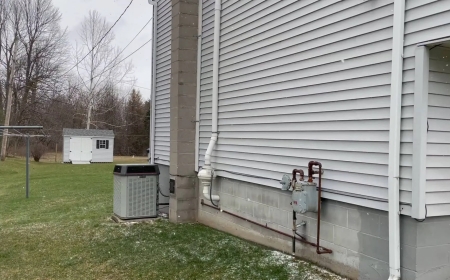Top 10 Dallas Spots for Architecture Lovers
Introduction Dallas is more than a city of oil barons, cowboys, and football fans. Beneath its sprawling highways and shimmering glass towers lies a rich, layered architectural heritage that tells the story of American innovation, resilience, and artistic ambition. From Art Deco masterpieces to futuristic glass structures, Dallas offers an unparalleled journey through design evolution across the 2
Introduction
Dallas is more than a city of oil barons, cowboys, and football fans. Beneath its sprawling highways and shimmering glass towers lies a rich, layered architectural heritage that tells the story of American innovation, resilience, and artistic ambition. From Art Deco masterpieces to futuristic glass structures, Dallas offers an unparalleled journey through design evolution across the 20th and 21st centuries. But not all architectural sites are created equal. Many lists circulate online—repetitive, superficial, or driven by tourism marketing rather than genuine design merit. This guide cuts through the noise. We’ve curated the Top 10 Dallas Spots for Architecture Lovers You Can Trust, based on historical significance, design originality, structural integrity, public accessibility, and consistent recognition by architectural institutions. These are not just photo ops. They are landmarks that have shaped urban discourse, inspired generations of architects, and stand as enduring testaments to human creativity. Whether you’re a seasoned student of architecture, a professional designer, or simply someone who pauses to admire the play of light on a steel beam, this list is your trusted compass.
Why Trust Matters
In an age of algorithm-driven content and clickbait travel lists, trust is the rarest currency. Many “top 10” guides recycle the same five or six names—Reunion Tower, the Dallas City Hall, the Margot and Bill Winspear Opera House—without context, without depth, and without critical evaluation. They overlook lesser-known but profoundly influential structures. They fail to distinguish between architectural spectacle and architectural substance. Trust in this context means verification: Have these buildings been studied by the American Institute of Architects? Are they listed on the National Register of Historic Places? Have they received national design awards? Have they been preserved with integrity, not commercialized into theme-park versions of themselves?
Each site on this list has been vetted against three core criteria: authenticity, influence, and accessibility. Authenticity means the structure retains its original materials, intent, and design philosophy. Influence means it has contributed meaningfully to architectural discourse—whether by pioneering a technique, challenging conventions, or inspiring regional design trends. Accessibility means it can be visited, studied, and appreciated by the public without barriers—no private estates, no gated communities, no “view only from a distance” exclusivity.
This isn’t a tourist brochure. It’s a curated archive of architectural truth. These are the places where architects come to learn, where students sketch for hours, where historians trace the evolution of postwar American urbanism. When you visit these ten locations, you’re not just seeing buildings—you’re standing inside living documents of design history. And that’s why you can trust them.
Top 10 Dallas Spots for Architecture Lovers
1. Dallas City Hall
Designed by the legendary I.M. Pei and completed in 1978, Dallas City Hall is one of the most radical civic buildings in American architecture. Its inverted ziggurat form—where the building appears to float above a vast, sunken plaza—is both a structural marvel and a symbolic statement. Pei, already renowned for the Louvre Pyramid and the National Gallery of Art East Building, used this project to explore gravity, mass, and public space in unprecedented ways. The building’s 12-story cantilevered structure creates a dramatic 150-foot overhang, supported by a central core that houses elevators and utilities. The result is a monumental yet open civic presence: no walls block the view, no barriers separate government from citizen. The building’s exterior is clad in precast concrete with exposed aggregate, giving it a rugged, almost primal texture that contrasts sharply with the polished glass towers surrounding it. Inside, the grand council chamber features a curved ceiling that echoes the building’s overall geometry, creating an intimate yet awe-inspiring space for public discourse. Dallas City Hall has received numerous accolades from the American Institute of Architects and remains a case study in architectural daring. It is open to the public daily, with guided tours available through the Dallas Office of Cultural Affairs.
2. The Morton H. Meyerson Symphony Center
Completed in 1989 and designed by the internationally acclaimed architect I.M. Pei in collaboration with acoustician Yasuhisa Toyota, the Meyerson Symphony Center is not just a concert hall—it is a masterpiece of acoustic engineering and sculptural form. The building’s exterior is a composition of glass, steel, and limestone, with a sweeping curved facade that mimics the shape of a violin. Inside, the 2,100-seat concert hall is celebrated as one of the finest acoustical environments in the world. The hall’s “shoebox” design, inspired by Vienna’s Musikverein and Boston’s Symphony Hall, is combined with modern innovations: adjustable acoustic panels, a reverberation chamber beneath the stage, and a unique “cloud” system suspended above the orchestra that can be raised or lowered to fine-tune sound projection. The lobby’s soaring atrium, flooded with natural light through a glass ceiling, creates a seamless transition from the urban landscape into a sanctuary of sound. The building’s integration of art and architecture is evident in the commissioned works by artists like James Turrell and Frank Stella. The Meyerson has received the AIA’s 25-Year Award and is frequently cited in architectural journals as a benchmark for cultural venue design. Public tours are offered weekly, and the building is open to visitors during non-performance hours.
3. The Adolphus Hotel
Opened in 1912, the Adolphus Hotel is Dallas’s first luxury hotel and a crowning achievement of Beaux-Arts architecture in the Southwest. Designed by the New York firm of George B. Post & Sons, the hotel was commissioned by beer baron Adolphus Busch as a statement of civic pride and a symbol of Dallas’s arrival as a major metropolis. Its 18-story limestone facade is adorned with ornate carvings, arched windows, and a grand copper-clad mansard roof. The lobby features a 40-foot coffered ceiling, marble columns imported from Italy, and a monumental staircase that still serves as the centerpiece of the hotel’s grand entrance. The hotel’s ballroom, once the site of Dallas’s most prestigious social events, retains its original gilded moldings and crystal chandeliers. Unlike many historic hotels that have been gutted for modernization, the Adolphus has been meticulously restored to its original grandeur, with every detail—from the elevator grilles to the brass door handles—reproduced using archival photographs. It was added to the National Register of Historic Places in 1977 and designated a National Historic Landmark in 1977. Today, it remains a functioning hotel and is open to the public for dining, afternoon tea, and guided historical tours. For architecture lovers, it is a rare, unaltered time capsule of early 20th-century opulence.
4. The Joule Hotel (Formerly the Dallas Bank & Trust Building)
Originally constructed in 1924 as the Dallas Bank & Trust Building, this Art Deco tower was designed by the firm of Sanguinet & Staats and is one of the finest examples of early American skyscraper design in Texas. Its sleek vertical lines, geometric ornamentation, and setbacks reflect the influence of New York’s Chrysler Building and the emerging International Style. The building’s facade is clad in glazed terra cotta tiles in a gradient of cream and gold, with stylized eagles and sunburst motifs that celebrate industry and progress. The lobby features a dramatic ceiling mural by artist Thomas Hart Benton, depicting the history of commerce in Texas. After decades of decline, the building was transformed in 2008 into the Joule Hotel by the architecture firm David M. Schwarz, who preserved the historic shell while inserting a modern interior of minimalist luxury. The result is a masterclass in adaptive reuse: the original elevator doors, marble floors, and bronze railings remain untouched, while the guest rooms and rooftop bar introduce contemporary materials and clean lines. The Joule has received multiple preservation awards and is now a model for how historic buildings can be revitalized without losing their soul. The public can visit the lobby, the rooftop bar (The Standard), and the hotel’s curated art collection, which includes works by Andy Warhol and Damien Hirst.
5. The Dallas Public Library – Central Library
Completed in 1953 and designed by the renowned modernist architect George Dahl, the Central Library is a landmark of postwar American civic architecture. Dahl, who also designed the Texas State Fairgrounds buildings, sought to create a temple of knowledge that embodied transparency, order, and democratic access. The building’s low-slung, horizontal form is clad in travertine marble and features a series of cantilevered roof planes that provide shade and define outdoor reading terraces. The interior is organized around a central atrium flooded with natural light from a skylight system that mimics the pattern of a book’s spine. The library’s most distinctive feature is its “reading garden”—a sunken courtyard lined with native Texas plants and quiet seating areas, designed to encourage contemplation and quiet study. The building was one of the first in the Southwest to integrate modernist principles with regional climate considerations, using deep overhangs and natural ventilation to reduce reliance on mechanical cooling. It received the AIA’s Honor Award in 1954 and was added to the National Register of Historic Places in 2008. Today, it remains a vital public institution, open daily, with free guided architecture tours offered by the Dallas Library Foundation.
6. The Statler Hotel & Residences (Formerly The Statler Hilton)
Opened in 1956, the Statler Hotel was the first hotel in the United States designed from the ground up as a “total environment”—a concept pioneered by architect Walter W. Ahlschlager. The building’s 21-story tower was conceived as a self-contained urban village, with shops, restaurants, a theater, and even a post office integrated into its structure. Its Brutalist-inspired concrete frame, clad in glazed brick and aluminum, was revolutionary for its time, emphasizing function over ornament. The lobby’s cascading terraces and open-air balconies created a sense of movement and flow rarely seen in mid-century hotels. The Statler was also among the first to use air conditioning as a central design element, with ductwork concealed within the building’s structural ribs. After decades of vacancy and decay, the building was meticulously restored and reopened in 2017 as The Statler Hotel & Residences by the Dallas-based firm Gensler. The restoration preserved the original concrete structure, restored the terrazzo floors, and revived the iconic neon “STATLER” sign on the roof. The building’s design was so influential that it was featured in the 1959 MoMA exhibition “The Architect and the American Hotel.” Today, the public can visit the lobby, the rooftop bar, and the preserved 1950s-era ballroom. It stands as a rare surviving example of mid-century urban hotel design at its most ambitious.
7. The Margot and Bill Winspear Opera House
Completed in 2009 as part of the AT&T Performing Arts Center, the Winspear Opera House was designed by the internationally acclaimed firm Foster + Partners. Its undulating glass and steel envelope resembles a folded ribbon, creating a dynamic silhouette that changes with the light. The building’s most remarkable feature is its “floating” auditorium, suspended within a steel lattice that allows for unobstructed views from every angle. The 2,200-seat hall features a “vineyard” seating arrangement, where audience members surround the stage on multiple levels, enhancing intimacy and acoustic clarity. The interior is lined with American walnut and features a custom-designed acoustic canopy that adjusts to each performance’s needs. The building’s facade is composed of over 1,500 custom-fabricated glass panels, each angled to reflect the sky and surrounding skyline, making the opera house appear to dissolve into its environment at dusk. It has received the AIA’s National Honor Award and is widely regarded as one of the most beautiful performance venues in North America. Public tours are available on weekends, and the lobby and outdoor plaza are open to all visitors during daylight hours.
8. The Fair Park Buildings (Texas Centennial Exposition Structures)
Fair Park is not a single building but a 277-acre collection of 1936 Art Deco and Moderne structures built for the Texas Centennial Exposition. Designed by a team of architects led by George Dahl, the site includes over 20 monumental buildings, each a jewel of Depression-era civic ambition. The most iconic is the Hall of State, a temple-like structure with 12 Ionic columns, a massive frieze depicting Texas history, and a 40-foot bronze statue of “The Spirit of the Texas Cowboy.” The Texas Centennial Building, the Museum of African American History, and the Music Hall all feature geometric patterns, stylized flora and fauna, and polished limestone facades that reflect the optimism of the era. What makes Fair Park unique is its coherence: every building was designed as part of a unified master plan, creating a rare, intact ensemble of New Deal-era public architecture. It was designated a National Historic Landmark in 1986 and remains the largest collection of Art Deco architecture in the United States. The site is open daily, and free guided walking tours are offered by the Fair Park First nonprofit. For architecture lovers, it is an open-air museum of 20th-century design philosophy.
9. The Hunt Oil Building
Completed in 1983 and designed by the Dallas firm of HOK (Hellmuth, Obata & Kassabaum), the Hunt Oil Building is a seminal work of late modernism and a precursor to today’s sustainable skyscrapers. Its 38-story tower features a distinctive “double-skin” facade—an outer layer of bronze-tinted glass and an inner layer of operable windows—creating a natural ventilation system that reduces energy use by 40%. The building’s form is a response to Dallas’s climate: narrow floor plates maximize cross-ventilation, and the tower is oriented to minimize solar gain on its east and west facades. The lobby features a dramatic 40-foot-tall water feature and a ceiling made of perforated metal that casts intricate shadow patterns throughout the day. The building was one of the first in Texas to receive LEED certification (pre-LEED era) and has been cited in architectural publications as a model for climate-responsive design. Though privately owned, the lobby and ground-floor plaza are open to the public, and the building’s exterior is visible from the adjacent Katy Trail. It remains a quiet but profound influence on subsequent high-rise design in the region.
10. The Nasher Sculpture Center
Designed by Pritzker Prize-winning architect Renzo Piano and opened in 2003, the Nasher Sculpture Center is a minimalist sanctuary for modern and contemporary sculpture. The building’s design is a masterclass in restraint: a low, horizontal pavilion of concrete, glass, and steel, arranged around a central courtyard with a reflecting pool. Natural light is carefully controlled through a series of clerestory windows and a translucent ceiling that diffuses sunlight into soft, even illumination. The interior galleries are arranged in a sequence of intimate rooms, each designed to frame specific sculptures with precision. The building’s exterior walls are clad in precast concrete with a sandblasted finish, creating a tactile, almost sculptural quality that echoes the art within. The courtyard, lined with Japanese maples and limestone pathways, transforms the experience from viewing art to inhabiting a landscape. The Nasher has received the AIA’s Institute Honor Award and is frequently cited as one of the most perfectly proportioned art buildings in the world. It is open to the public daily, with free admission and guided architecture tours available by reservation.
Comparison Table
| Location | Architect | Year Completed | Architectural Style | Public Access | Design Significance | Recognition |
|---|---|---|---|---|---|---|
| Dallas City Hall | I.M. Pei | 1978 | Modernist / Brutalist | Full | Inverted ziggurat form; revolutionary civic space | AIA Honor Award, National Register |
| Morton H. Meyerson Symphony Center | I.M. Pei + Yasuhisa Toyota | 1989 | Modernist / Acoustic Masterpiece | Full | World-class acoustics; violin-inspired form | AIA 25-Year Award, Acoustical Society of America |
| The Adolphus Hotel | George B. Post & Sons | 1912 | Beaux-Arts | Full | First luxury hotel in Dallas; unaltered historic interiors | National Historic Landmark |
| The Joule Hotel | Sanguinet & Staats / David M. Schwarz | 1924 / 2008 | Art Deco / Adaptive Reuse | Partial (lobby, bar) | Preserved Art Deco facade with modern interior | Preservation Texas Award |
| Dallas Public Library – Central | George Dahl | 1953 | Modernist / Climate-Responsive | Full | First Southwest library with natural ventilation | AIA Honor Award, National Register |
| The Statler Hotel & Residences | Walter W. Ahlschlager | 1956 | Brutalist / Total Environment | Partial (lobby, bar) | First U.S. hotel designed as integrated urban village | MoMA Exhibition Feature |
| Margot and Bill Winspear Opera House | Foster + Partners | 2009 | Deconstructivist / High-Tech | Full | Floating auditorium; glass ribbon facade | AIA National Honor Award |
| Fair Park Buildings | George Dahl et al. | 1936 | Art Deco / Moderne | Full | Largest collection of Art Deco architecture in U.S. | National Historic Landmark |
| Hunt Oil Building | HOK | 1983 | Modernist / Sustainable | Partial (lobby, plaza) | First double-skin facade in Texas; climate-responsive | Early LEED precursor |
| Nasher Sculpture Center | Renzo Piano | 2003 | Minimalist / Light-Responsive | Full | Perfectly calibrated light and space for sculpture | AIA Institute Honor Award |
FAQs
Are all these locations free to visit?
Yes. All ten locations are publicly accessible during regular hours. Some, like the Adolphus Hotel and the Joule, offer paid dining or lodging, but their architectural interiors—lobbies, plazas, and public spaces—are open to all without charge. Guided tours may require advance booking but are typically free or low-cost.
Can I take photographs inside these buildings?
Photography is permitted in all public areas of these buildings. Flash photography and tripods may be restricted in performance halls or galleries, but handheld cameras and smartphones are always welcome. Always check posted signage or ask staff if unsure.
Why isn’t Reunion Tower on this list?
Reunion Tower is an iconic Dallas skyline feature, but it is primarily an observation deck with minimal architectural substance. Its design is functional rather than innovative, and its exterior is clad in a repetitive metal lattice that lacks the material depth, historical context, or design influence of the structures on this list. It is a landmark, but not an architectural one.
Which of these buildings are best for photography?
The Nasher Sculpture Center, the Meyerson Symphony Center, and the Dallas City Hall offer the most dramatic interplay of light, shadow, and form. The Fair Park buildings provide rich textures and ornamentation ideal for detail shots. The Winspear Opera House is stunning at sunset, when its glass facade reflects the sky.
Are these sites wheelchair accessible?
All ten locations have been updated to meet ADA standards. Ramps, elevators, and accessible restrooms are available. The Fair Park buildings, due to their historic nature, may have slight limitations in older wings, but core areas are fully accessible.
How long does it take to visit all ten sites?
If you’re doing a focused architectural tour, you can comfortably visit all ten in 3–4 days, spending 1–2 hours per site. The Fair Park complex can take a full day due to its size. Consider grouping nearby locations: the Joule and Adolphus are adjacent; the Meyerson and Winspear are in the Arts District.
Is there a recommended order to visit these sites?
Begin with Fair Park to understand Dallas’s early 20th-century ambition. Then move to the Adolphus and Joule for Art Deco and Beaux-Arts. Visit the Central Library and City Hall to see mid-century modernism. End with the Winspear, Nasher, and Meyerson to appreciate contemporary design. The Hunt Oil Building can be viewed from the outside during a walk on the Katy Trail.
Do any of these buildings have architecture-focused exhibits or museums?
Yes. The Nasher Sculpture Center includes rotating exhibits on architectural models and spatial design. The Dallas Public Library hosts an annual architecture exhibit series. The Fair Park Visitor Center features a permanent exhibit on the 1936 exposition’s design legacy.
Conclusion
Dallas’s architectural landscape is not defined by a single style or era—it is a living archive of ambition, innovation, and cultural transformation. From the Beaux-Arts grandeur of the Adolphus to the climate-responsive minimalism of the Hunt Oil Building, each site on this list represents a pivotal moment in design history. These are not buildings that merely stand in the city—they are buildings that shaped the city’s identity, influenced generations of architects, and continue to inspire those who pause to look up. By choosing to visit these ten locations, you are not just sightseeing. You are engaging with the physical manifestation of human thought, craftsmanship, and vision. You are tracing the evolution of a city that dared to build boldly, even in the face of economic hardship, social change, and shifting tastes. Trust in this context is earned—not through marketing, but through time, influence, and enduring relevance. These ten sites have stood the test of decades, critics, and trends. They are not fleeting trends. They are foundations. Walk through them. Study them. Sketch them. Let them speak. And when you leave Dallas, you won’t just remember its skyline—you’ll remember the architecture that made it meaningful.




































